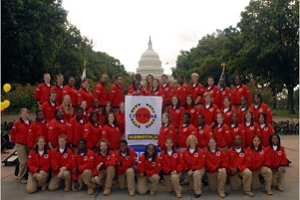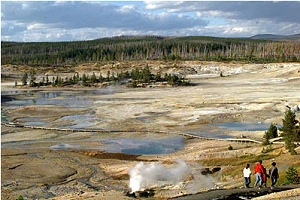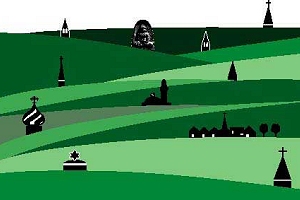America in context
Minority Groups Now One-Third of U.S. Population

The United States Census Bureau announced in 2006 that as many as one-third of U.S. residents now claim "minority" heritage, reflecting the continuing evolution of an American national identity that transcends ethnic and religious boundaries.
It also raises some interesting questions. Who is a minority, after all? What will "minority" mean in a future America increasingly populated by individuals like the young man who described himself as "an Amer-Asian kid who celebrates Hanukkah with his Jewish stepfather, prays to Buddha with his Buddhist Momma, and then goes to midnight Mass with his Christian father and waits for Santa Claus to come down the chimney?"
Even as Hispanics, Blacks, Asians and American Indian/Alaska natives account for over four-fifths of recent U.S. population growth, the influence that these and other American cultures have on one another continues to develop, in a process as old as the nation itself.
A HISTORY OF DIVERSITY
The thirteen English North American colonies offered refuge for religious dissidents and economic opportunity for individuals seeking a fresh start—not just for subjects of the English Crown, but for ambitious, highly driven individuals from different parts of Europe, and later from nearly every corner of the globe.
While Americans treatment of dispossessed Native Americans and enslaved African Americans belied our ideals of tolerance and freedom, Americans have for most of their history welcomed large numbers of diverse immigrants and treated them as full-fledged Americans.
Speaking in 1858, two years before his election to the presidency, Abraham Lincoln observed that fully half of that eras Americans were either immigrants, or descendants of those who arrived after the United States achieved independence. These Americans, he said, were "our equals in all things … and … they have a right to claim it as though they were blood of the blood, and flesh of the flesh of the men who wrote that Declaration [of Independence]."
MINORITIES SPUR 21ST CENTURY GROWTH
As in Lincolns day, immigrants and their descendants help drive Americas population growth and economic dynamism even as they enrich and enliven its cultural mosaic.
The Census Bureau reports that Hispanics accounted for nearly half of U.S. population growth during the period July 1, 2004–July 1, 2005. The Hispanic population increased by 1.3 million (3.3 percent) during that period, 800,000 by natural increase and 500,000 through immigration.
The Asian American population increased by 421,000 (3 percent) during that period, while Black, American Indian, Alaska native, Native Hawaiian and Pacific islander populations also increased.
As of July 2005, the Census Bureau reports a total U.S. population of 296.4 million. Of this total, Hispanics comprise 42.7 million Americans while blacks, including both African Americans and more recently arrived Africans and blacks of Caribbean origin, total 39.7 million. The Census identified 14.4 million Asians, 4.5 million American Indians and Alaska natives and nearly 1 million native Hawaiians and Pacific islanders.
"These mid-decade numbers provide further evidence of the increasing diversity of our nations population," said Census Bureau Director Louis Kincannon.
The nations minority population is younger than the national average. It is thus expected both to contribute to continued economic growth and to help ensure the vitality of public welfare programs serving older Americans.
The Washington Post reported in May 2006 that nearly half of the nations children under 5 are racial or ethnic minorities.
As the nation’s minority population increases, the Census Bureau also reports sharp growth in minority-owned businesses. Even as these entrepreneurs strive to serve their communities needs, they add to the influence of minority groups on American life.
THE FUTURE: EVERYONE A MINORITY?
Future Americans may come to view the very concept of minority groups as a thing of the past. With intermarriage rates high, the American future may come to resemble well-known individuals of mixed racial heritage, like golfer Tiger Woods, actor Keanu Reeves or singer-songwriter Norah Jones. As Gregory Rodriguez, Irvine Senior Fellow at the New America Foundation, writes: "What, when each generation is more racially and ethnically mixed than its predecessor, does race even mean any more?”
The Orange County (California) Register reports on the rise of the "hapa" American. Derived from the Hawaiian term "hapa haole," or "half white," it has been adopted by Americans of mixed Asian or Asian and other parentage.
Hapas have grown significantly in number, and now are the second largest subgroup (after the Chinese) in the Asian Pacific American population. Hapa encompasses a kaleidoscopic range of identities. Early Sikh immigrants to California often intermarried with Mexican American women. Second- and third-generation Japanese Americans (nisei and sansei) have "out-married" in significant numbers.
At Cornell University, the student Hapa organization decided that "mixed Asian ancestry" was too restrictive a definition. It expanded criteria for membership to "all mixed (and non-mixed people)." Hapas are not a separate group, but part of the constituency of every ethnic community," the students wrote.
The 2000 Census was the first to afford Americans the opportunity to identify themselves as "mixed race" or "mixed ethnicity." This was not enough for Sean Lennon, son of English musician John Lennon and Japanese-American Yoko Ono. Lennon has proudly adopted the hapa identity. "Im not asking for hapa history month, but how about a weekend?" he has written.
By Michael Jay Friedman
Washington File Staff Writer
More information on minorities in the U.S. population is available on the Census Bureau Web site.
Recently on America in context
Volunteerism Is Integral Part of U.S. Culture
 University students represent a large and growing source of the nation's volunteers, according to the Corporation for National and Community Service, an independent federal agency that provides grants and other support to volunteer organizations throughout the country.
University students represent a large and growing source of the nation's volunteers, according to the Corporation for National and Community Service, an independent federal agency that provides grants and other support to volunteer organizations throughout the country.
Sharing Our National Park System With the World
 The United States launched a conservation ethic with establishment of Yellowstone National Park in 1872 and today manages some 34 million hectares in parks and 36.4 million hectares in wildlife refuges. The country is committed to helping other countries share in the conservation and economic benefits of land and wildlife preservation.
The United States launched a conservation ethic with establishment of Yellowstone National Park in 1872 and today manages some 34 million hectares in parks and 36.4 million hectares in wildlife refuges. The country is committed to helping other countries share in the conservation and economic benefits of land and wildlife preservation.
Religion in America
 One of the bedrock principles of the United States is religious liberty and the separation of church and state. At the time the Republic was founded more than two centuries ago, the overwhelming majority of Americans were Christians. Since that time, however, the United States has become the worlds most religiously diverse society, especially during the last three decades.
One of the bedrock principles of the United States is religious liberty and the separation of church and state. At the time the Republic was founded more than two centuries ago, the overwhelming majority of Americans were Christians. Since that time, however, the United States has become the worlds most religiously diverse society, especially during the last three decades.